Margaret Skinnider—a life after revolution
Published in Features, Issue 2 (March/April 2020), Volume 28The rich, varied, active and very political life of a committed feminist, trade union activist and republican.
By Mary McAuliffe
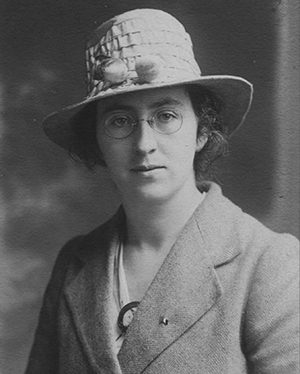
Above: Margaret Skinnider in Glasgow, c. 1914.
There has been an upsurge in the researching and writing of Irish revolutionary women’s history in recent years, with a corresponding public interest in and engagement with the lives, activisms and contributions of these women. As a result of the work, mainly, of female historians, revolutionary histories are now regarded as presenting an incomplete analysis if they do not also include the contributions and activities of women. This is only to be welcomed. Nevertheless, the activism and contributions of these women are often included only as a singular aspect of their lives; full biographies of revolutionary women are few and far between. Recent welcome contributions have included the expanded and reissued biography of Hanna Sheehy Skeffington by Margaret Ward, the books on Rosamond Jacob and, more recently, Dorothy Macardle by Leeann Lane, and Lauren Arrington’s Revolutionary lives—Constance and Casimir Markievicz.
Archives not gender-neutral
There are significant issues with the writing of women’s biographies. Archives, for instance, are not immutable, gender-neutral repositories of knowledge, which means that they can be both indispensable to and inadequate for writing women’s lives. Women’s lives and voices can be obscured, invisible or underrepresented in archives. The papers of even well-known or ‘achieving’ women often remain uncatalogued, perhaps hidden in the archives of male relatives or comrades—or, indeed, not deposited at all, as their lives and activities were not considered important enough to warrant an archive. In the case of Irish revolutionary women, one of the most important sources is the Military Archives, especially the Bureau of Military History and the Military Pension Applications. In 1947 the Bureau of Military History was established ‘to assemble and coordinate material to form the basis for the compilation of the history of the movement for independence’. About 1,770 statements were collected from former members of the Irish Volunteers, the Irish Citizen Army, the Irish Republican Brotherhood, Sinn Féin and Cumann na mBan. Women’s contributions, however, comprised less than 10% of these, reflecting, as Ferghal McGarry notes, ‘contemporary assumptions about the relative importance of their contribution’. While many more women applied for pensions and gave testimony to the Military Pensions Board, their names and stories are only now becoming familiar to us with the digitisation of these records.
The ‘decade of centenaries’ has in many ways been a boon for the histories of Irish revolutionary women. During the 2016 commemorations of the 1916 Rising, one of the female participants whose story came very much into the public arena was Margaret Skinnider. Skinnider, a member of the Anne Devlin branch of Cumann na mBan in Glasgow, joined Michael Mallin and the Irish Citizen Army garrison at the Royal College of Surgeons (RCSI) to fight in the Rising. Although born in Scotland, she was of Irish descent and was much influenced by militant feminist and Irish nationalist politics during her formative years there. A militant suffragette by 1912, she also helped train the Glasgow sluagh of Na Fianna, worked with the Irish Volunteers there and joined Cumann na mBan in 1915.
A sniper in 1916
In December 1915 Skinnider made a visit to Dublin at the invitation of Countess Markievicz. Crossing on the mail-boat from Glasgow, she had bomb-making equipment, destined for Connolly and the Irish Citizen Army, concealed on her person. Her commitment to the cause of Ireland impressed both Connolly and Markievicz, and before returning to Glasgow early in 1916 she was apprised of some of the plans for the Rising, enough to know that she would be back in Dublin by Easter. Her participation in the Rising is the best-known part of her life story because she was one of the few women who used a gun and because she wrote one of the first eyewitness accounts of Easter Week, which was published in America in 1917. Being a trained markswoman, she acted as a sniper and led an action against a British Army sniper nest on Harcourt Street, during which she was seriously wounded.
After the Rising, Skinnider was one of the many women who took part in the Irish republican women’s propaganda tour in America. While there, she wrote Doing my bit for Ireland, her memoir of her journey to participation in and experience of the Easter Rising. As a reviewer said of the book, ‘it makes the Irish revolutionaries live for us … so that the Irish question presents itself as an essentially human problem and the rights of small nations changes from a battle cry to a demand for constructive thought’. Skinnider returned to Dublin in 1919 and participated in the War of Independence as a member of the Fairview branch of Cumann na mBan. She took an anti-Treaty stance and was an active anti-Treaty militant during the bombardment of the Four Courts. With the arrest of many of the anti-Treaty republican leadership, she took on the role of paymaster general of the IRA until she was herself arrested in December 1922. She spent almost a year in prison, in Mountjoy and in the North Dublin Union, being released in early December 1923.
Military pension refused
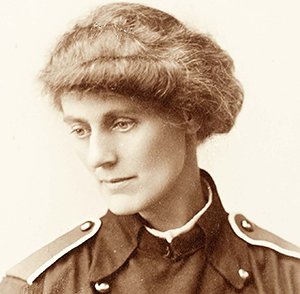
Above: Countess Markievicz—at her invitation Skinnider visited Dublin in December 1915. Five months later the countess would be Skinnider’s commanding officer in the College of Surgeons, St Stephen’s Green. (NLI)
Much of this part of Skinnider’s story is well known, as is her unsuccessful application for a military pension in 1925. The authorities stated that the Military Service Pensions Act was only applicable ‘to soldiers as generally understood in the masculine sense’. This was a convenient excuse, as those considering her application also noted that she was a ‘prominent Irregular’. W.T. Cosgrave, president of the Irish Free State executive, was determined that his government would ‘not pay the pension of any person who has been in arms, or otherwise seriously responsible, in connection with the late outbreak’ (the Civil War), so Skinnider and, indeed, many anti-Treaty men were refused pensions. A sentence in the pension application of Bríd Connolly, a member of the central executive of Cumann na mBan, indicated that Skinnider, ever the activist, knew what she was doing. She had applied ‘as an experiment to see if they would give it to her’. Other than this, Margaret Skinnider, who lived until 1971, rarely appears in the pages of Irish history books.
Subsequent disappearance from the archives
There are no Skinnider manuscripts in any Irish or Scottish archives. Despite the fact that she kept a lifelong diary and was an enthusiastic photographer, no one thought to deposit this material in archives after her death. How, then, do we research and write the history of a woman who lived for 50 years after her last historical mention? Or is it the case, as one scholar wrote, that ‘Margaret Skinnider’s bravery in the uprising did not lead to a politically active career; after the turmoil was over she quietly settled down to be a school teacher’?
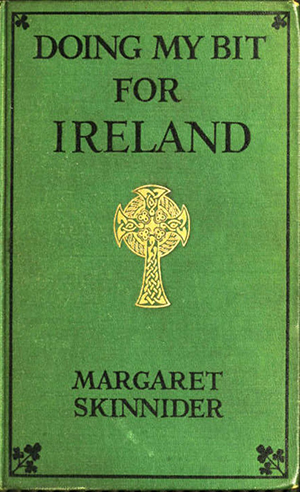
Above: Skinnider’s Doing my bit for Ireland—one of the first eyewitness accounts of Easter Week, published in America in 1917.
Feminist scholars often talk about the many and divergent methodologies necessary to unpack the whole life cycle of a female subject, especially one lacking a personal, accessible archive. As feminist historian Barbara Caine wrote, ‘through the detailed exploration of individual lives, one also gains an awareness of the complexity and diversity of feminism’—or, indeed, any other activism by a woman. As Caine further notes, there is a real need to see a woman’s activism ‘in close relationship with the whole range of familial, religious, social and personal ties, beliefs and values’. To write the entire life cycle of a female subject, the public and the personal are intertwined and of interest to the scholar; with this understanding, the subject’s life can be given form and substance. We can learn what motivated militant or political women, what ideologies they espoused, how long they continued in activism, how this affected their personal and public lives, and the influence of the legacy of their contributions to their communities and societies. Lacking personal archival material, or having few personal traces or sources, the scholar often must ‘research around’ the subject to reconstruct a life from fragments, traces, silences, subtexts and absences.
Post-revolutionary life
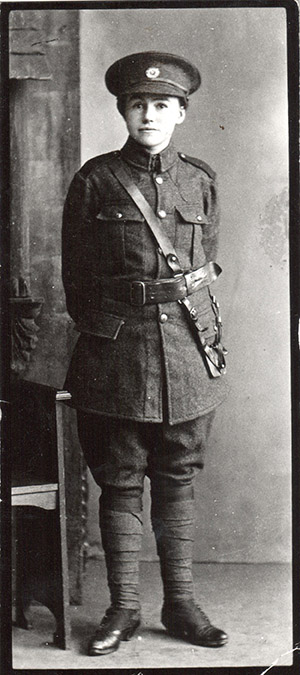
Above: Nora Connolly, second daughter of James, c. 1916. Skinnider had always remained close to her, personally and politically, and was part of the short-lived Workers’ Party of Ireland (WPI), which Nora had co-founded with her brother Roddy in 1926. (Kilmainham Gaol)
And so it was with the post-revolutionary life of Margaret Skinnider. Certain aspects of her life appear in short biographies; she did indeed return to teaching and by 1928 had secured a position at the Sisters of Charity primary school in King’s Inn Street in Dublin, remaining there until her retirement in 1959. She was a member of the Irish National Teachers’ Organisation (INTO) and became its president in 1956. She died in 1971 and was buried in the republican plot beside her Irish Citizen Army comrade Countess Markievicz in Glasnevin Cemetery, Dublin. She never married. These few sentences, however, also make invisible the lifelong rich, varied, active and very political life of a committed feminist, trade union activist and republican.
Skinnider remained an executive member of Cumann na mBan into the 1930s. Once she had returned to teaching she joined the INTO. She had always remained close, personally and politically, to Nora Connolly O’Brien and was part of the short-lived Workers’ Party of Ireland (WPI), which Connolly O’Brien had co-founded, with her brother Roddy, in 1926. In 1932, a few years after Skinnider returned to teaching, the INTO was notified by letter that ‘all women national teachers who qualified on or after 1 April 1932 shall, on marriage, cease to be eligible for recognition in any capacity in a national school’. This ‘marriage bar’ never affected Skinnider personally but one of her lifelong aims was to have it overturned—which it was in 1958, two years after she retired as president of the INTO. She was a committed trade union activist and educationalist and was on the strike committee for the seven-month-long strike by the Dublin members of the INTO in 1946.
The inconclusive end to that strike led many teachers to distrust the more mainstream political parties, and many, like Skinnider, were attracted to a newly formed party, Clann na Poblachta, which offered a ‘revivalist form of republicanism allied to social reform’. Skinnider joined several revolutionary comrades in Clann, such as Sighle Humphries, Kathleen Clarke, Caitlin Brugha and Kathleen Barry Moloney. She was soon electioneering for the party and was elected to its central executive. In 1949 a representative committee on teachers’ salaries was set up under the chairmanship of Judge P.J. Roe (the Roe Commission). Skinnider was one of the six INTO members on the Commission; the report, which was delivered in May 1949, recommended a common pay scale for male and female teachers, with a marriage allowance for married men and additional bonuses for those with honours degrees. In 1950 she ran, unsuccessfully, as a Clann na Poblachta candidate for a seat on Dublin Corporation.
Her INTO career flourished on into the 1950s and she was a well-known national figure in trade union activism. Several areas of policy drove her involvement in the INTO, including removal of the marriage bar, equal pay and university training for all teachers, a common salary scale and a common retirement policy. She was regarded as an innovative and engaging teacher, campaigning for all pupils, including those with physical or intellectual impairments, to have equal access and equal opportunities in schools. She was concerned with the impact that hunger, bad housing conditions and poverty had on children. Delinquency and vandalism, she felt, should concern teachers and parents, and she was always emphatic that parental responsibilities were uppermost; in one speech she said that it was time that ‘we spoke about the rights of teachers and the duties of parents’. In 1956 she was elected president of the INTO and in July of that year she left for two months in Manila, the Philippines, to represent the trade union at the World Federation of Organisations of the Teaching Profession.
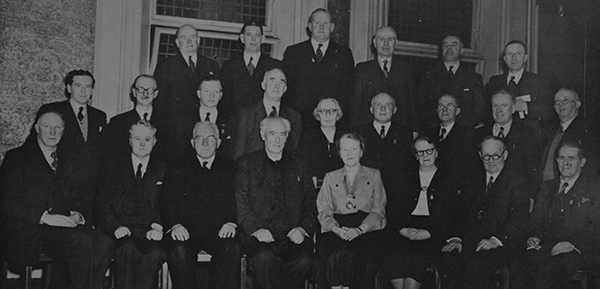
Above: Margaret Skinnider (middle of the second row) with other past presidents of the Irish National Teachers’ Organisation shortly before her death in October 1971. (An Múinteoir Náisiúnta)
Private life
Skinnider retired from teaching and from the INTO in 1959 but she did not retire from activism. In 1960 she was appointed chairman of the Women’s Advisory Committee (WAC) set up by the Irish Congress of Trade Unions (ICTU), to advise its executive council on issues relating to women in the trade union movement. Skinnider had begun her activist career in 1912 as a militant suffragette; she was now ending it as second-wave feminism was beginning, still fighting for the rights of women and, especially, for the rights of women workers. A close look at the life of Margaret Skinnider, using archival material from a multiplicity of sources, sources which filled the gaps left by the absence of any personal archival material, revealed a woman who committed herself, in a life that stretched from first- to second-wave feminism, to fighting for three causes: Ireland, women and workers. Not only, however, did these sources reveal a lifelong activist, and an important but overlooked national figure, but they also revealed a more hidden history—a private life shared with another woman. Skinnider and Nora O’Keeffe, also a revolutionary woman, a member of Cumann na mBan, an imprisoned anti-Treaty republican, a propagandist, a journalist and writer, met in 1919 and lived together in Dublin until O’Keeffe’s death in 1962. Their private life was revealed though letters in other political women’s archives, most notably that of Hanna Sheehy Skeffington, in newspaper reports and in the photographs of their life together, which remain in the Skinnider family private archive, as well as in conversations with relatives of both Skinnider and O’Keeffe.
Margaret Skinnider challenged the gendered hierarchies of her own time, she committed herself totally to important causes during a lifetime of activism, and she made choices in her personal life that were contrary to the expected norm of marriage and motherhood. She was never simply the ‘sniper girl on the Green’. In the 1992 Agenda for Irish women’s history, historian Maria Luddy wrote that, ‘in looking at the lives of individual women, we must investigate the connections which existed between their “public” and “private” worlds. Did these women create networks of support for their activities? What did they think about society and women’s position in it? How were their world-views formed?’ These and other questions need to be asked in full, extended studies of political, militant, suffrage, revolutionary and activist women. They are deserving biographical subjects. Their biographies would serve to challenge and question the myths and histories of the revolutionary period, uncover the processes by which gendered narratives were constructed and historicised, broaden our knowledge of the roles played by women and complicate our understanding of the period.
Mary McAuliffe is Assistant Professor of Gender Studies at University College Dublin.
FURTHER READING
M. McAuliffe, Margaret Skinnider, Historical Association of Ireland Life and Times New Series (UCD Press, 2010).
















